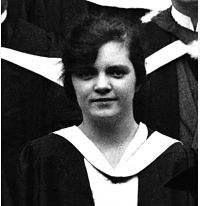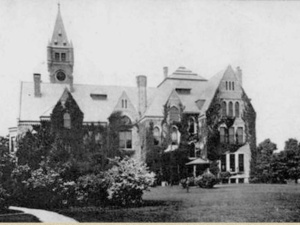Marion Gray
Mathematician
Image courtesy of Department (now School) of Mathematics, University of Edinburgh
- BORN 26th March 1902, Ayr, Ayrshire, Scotland
- DIED 16th September 1979, Edinburgh, Scotland
- WORKED Edinburgh, Scotland; London, England; New York City, USA; New Jersey, USA
- HONOURS Award-winning student – Napier Medal and Gadgil Prize from Edinburgh University, and Scholarship in Mathematics which enabled her to continue postgraduate study in the USA. Despite considerable achievement in her working life, it seems that she received no other honours.
Artistic Connections
There is no record of any artistic connections – so if you know of any please do contact us.
Music
Title: Minerva Mathematica
Music by: FRANCES M LYNCH
Words: Winton Mathematics Gallery exhibition, Science Museum, London – curator David Rooney; Sofia Kovalevskaya, Dr Patricia Fara, Geoffrey Chaucer
Written in: 2017
For: solo voice with a chorus of recorded voices
Performed by: Frances M Lynch (solo & chorus) and Chorus – Pippa J Redfern, Danielle Barry, Kathryn Holland, Miranda Melville, Colette Milward, Eloise Ward, Fiona McAlister
First Performance: Science Museum, London on 22nd Feb February 2017
First Broadcast: BBC Radio 3, Proms, June 5th 2018
“It is impossible to be a mathematician without being a poet in soul” Sofia Kovalevskaya (1850-1891) Mathematician
Time and Tide Wait for no Woman (an updated version of a Geoffrey Chaucer quote)
The piece reflects the research into Scottish Women Scientists by Catherine Booth (National Library of Scotland)
The music was first performed to an audience of over 3,000 people at a Science Museum Lates event celebrating the opening of the Winton Mathematics Gallery. It was recorded at Birnam Studios, London in February 2017 and produced by Herbie Clarke.
Education
Schooling at Ayr Academy; MA with First Class honours from University of Edinburgh; PhD from Bryn Mawr College, Pennsylvania, USA
Occupations
Assistant in Natural Philosophy
1926-1927. Following the award of her PhD from Bryn Mawr College, Pennsylvania, Marion Gray took up a post back at Edinburgh University
Research Assistant in Mathematics
1927-1930. Working at Imperial College, London
Engineer
1930-1934. Working in the Department of Development and Research, American Telephone and Telegraph Company
Mathematician
1934-1967. On the technical staff of Bell Telephone Laboratories (Bell Labs), specialising in mathematics and electromagnetic theory. She named her research interests as ‘wave propagation over the spherical earth, mathematical theory of antenna radiation, propagation of waves in loaded wave guides, and numerical analysis.’

Bell Telephone Laboratory, Murray Hill, New Jersey.
General view from near acoustics lab (1942)
(Source: Library of Congress)
Scientific Achievement
- Published several research papers, for example: The equation on conduction of heat. Proceedings of the Royal Society of Edinburgh, 45, issue 3 1926 pp. 230-244.
- Produced more than 250 reviews of mathematical papers published in different European languages, which she accompanied with clear explanations of the content of each paper.
- Contributed to the compilation of a Handbook of mathematical functions, published in 1954, for the US National Science Foundation, and the National Bureau of Standards.
- Discovered a remarkable cubic semi-symmetric graph with 54 vertices, which was found to be the smallest graph of its kind. This was in 1932, at a time when graph theory was almost non-existent. To Marion Gray then, it was simply a fascinating curiosity; she was not to know that graphs such as this were to become central in network theory, where efficient interconnections are essential. Her contribution was recognised in 1968, when a fellow mathematician rediscovered it. It is now known as the ‘Gray Graph’.
Did You Know?
Marion Gray had a twin sister, Ann J. Gray. A newspaper report from 1921 called them, “Brainy twins”, as it went on to talk about their achievements. Both Marion and Ann received bursaries to attend Edinburgh University, and while Marion studied mathematics, Ann studied Arts subjects, such as Latin and French. Both were awarded prizes during their undergraduate courses – Marion for English as well as mathematics and science courses, and Ann for languages and history. Nothing has so far been discovered about Ann’s career following university.
During the time Marion Gray was working there, Bell Labs were at the forefront of many major scientific advances such as: the first binary digital computer (1939); the invention of the transistor (1947); and the design and launch of Telstar, the first communications satellite (1962). There is no record that Marion Gray was part of the team which worked on any of these, but her place as one of the most highly regarded mathematicians there was recognised (see Inspiring woman section below).
Despite having become a naturalised US citizen in 1937, Marion Gray returned to Edinburgh when she retired, and lived there for the rest of her life. While mentioning her employment in the USA, her death notice simply describes her as a ‘much loved sister and aunt’
An Inspiring Woman
Marion Gray’s career, especially in her discovery of the Gray Graph, illustrates how ‘blue sky research’ can sometimes lead to significant future advances, even though its outcome is not recognised at the time.
Because she was one member of staff in a prestigious organisation, her contribution has not been singled out, but the following gives an example of how she was respected:
As a young physicist, Erich Schulz-Du Bois joined Bell Labs as a junior member of staff. In 1957, he was struggling with a task he had been assigned. The website describes how he was helped by ‘a little old lady, Marion Gray, one of Bell’s finest mathematicians at that time’…. The ‘little old lady’ would then have been about 55 years old! Schulz-Du Bois went on to become a noteworthy physicist and inventor.



